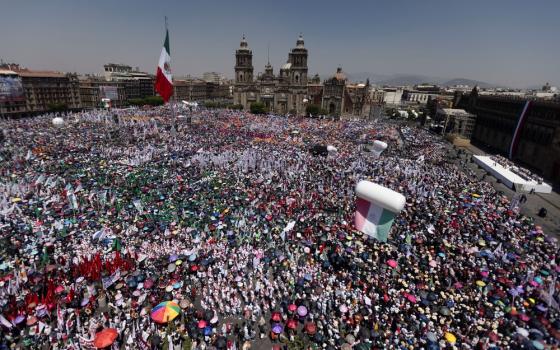Revelation can open our eyes to today’s idolatry and injustice, says author
APOCALYPSE AND ALLEGIANCE: WORSHIP, POLITICS, AND DEVOTION IN THE BOOK OF REVELATION
By J. Nelson Kraybill
Published by Brazos Press, $21.99
Get ready. Jesus is coming to Oakland, Calif. Well, not just to Oakland, for according to the Oakland-based Family Radio Worldwide, an independent Christian ministry led by Harold Camping, Jesus Christ will return on May 21 to whisk away all faithful Christians in the Rapture, to avoid the calamities about to plague the nonbelievers left on the planet.
Predictions about the end of the world are nothing new. One of the most famous in U.S. history happened when the Baptist farmer William Miller and his followers, who came to be known as the Millerites, experienced “The Great Disappointment.” Jesus did not come as expected on Oct. 22, 1844. Such letdowns have not deterred subsequent millennialists and dispensationalists of various stripes from continuing to make similar projections.
Indeed, a steady flow of cataclysmic speculations in recent decades includes many bestselling books, ranging from Hal Lindsey’s The Late Great Planet Earth (1970) to Tim LaHaye and Jerry Jenkins’ Left Behind series of novels. Hollywood, too, has cashed in on the widespread interest in religion and the apocalypse with blockbuster movies, such as “The Omen” in 1976 (and its sequels, as well as its remake in 2006) and most recently, “2012,” a disaster film based on prognostications from a Mayan calendar.
Many U.S. Christians in the United States, including Catholics and mainline Protestants, dwell in an end-time paradox. They pray or sing in the Gloria Patri, “world without end, amen,” yet cull their eschatology, or theology of the consummation of God’s kingdom (“on earth as it is in heaven”), from these more popular “The end is near” sources not at all congruent with the latest biblical scholarship. Admittedly, the latter resources have not always been made readily available to the people in the pews.
Although a cradle Catholic, after my parents’ divorce I was “adopted” during my high school years by an Assemblies of God church, where my father, stepmother and several close friends attended. There, I voraciously consumed the standard (and often anti-Catholic) fare about the so-called Rapture and the Antichrist (neither word, by the way, is found in the book of Revelation).
I wish J. Nelson Kraybill’s Apocalypse and Allegiance: Worship, Politics, and Devotion in the Book of Revelation, which is both scholarly and accessible, had been in print back then; I might have left behind my teen angst about being left behind by Christ sooner.
 Kraybill, who has served as president of Associated Mennonite Biblical Seminary in Elkhart, Ind., and has taught about Revelation for over two decades on four continents, does not try to provide a chapter-by-chapter, verse-by-verse commentary of the final book of the Bible. Rather, in 12 nicely written chapters he focuses on how “Revelation highlights the way worship, with its reliance on symbol, expresses and shapes allegiance.”
Kraybill, who has served as president of Associated Mennonite Biblical Seminary in Elkhart, Ind., and has taught about Revelation for over two decades on four continents, does not try to provide a chapter-by-chapter, verse-by-verse commentary of the final book of the Bible. Rather, in 12 nicely written chapters he focuses on how “Revelation highlights the way worship, with its reliance on symbol, expresses and shapes allegiance.”
In the first century, politics, economics and religion were not compartmentalized. They would “converge in acts of worship,” in allegiance to violent Roman emperors such as Nero or Domitian. For Jews and Christians, even coins such as the “render to Caesar” (Matthew 22:21) denarius shown to Jesus -- a coin that bore an image (eikÿn) of Emperor Tiberius and was inscribed “son of the divine Augustus” -- symbolized a usurpation of allegiance that rightfully belongs to God.
Revelation urged late-first-century Christians who occasionally experienced periods of intense persecution from the empire to keep the faith and to maintain their pledge of allegiance to Christ, even if it entailed martyrdom. This apocalyptic book employed symbolism and imagery that, while bewildering to us, clearly conveyed to the early churches their imperative to resist idolatrous devotion to the emperor. Its author, John of Patmos, directed Christians’ attention to their own alternative rituals and symbols (including sacraments such as baptism) that represented a shift in allegiance, namely, to the Lamb that was “slaughtered” (a word that, as Kraybill notes, meant “murdered” more than “sacrificed”). In Christian worship, “God’s design for the future begins to take tangible form, at least in part, through healing and hope in the restored community called the church,” a people who represent a way of life together in contrast to the violence and injustice of emperors and empires.
Although originally written for an audience nearly 2,000 years ago, Kraybill argues that this hopeful message has significance today. “We may need Revelation,” he writes, “to jolt us out of our slumber, to open our eyes to see idolatry and injustice that pervade globalization and empire today.” In addition to nationalism, there are now other functional equivalents of empire that seek to claim our ultimate commitment: the obvious consumerism and, I would add, an excessive focus on the family whereby blood is thicker than baptismal water. In short, whenever “our way of life” is invoked to rally the people to support any government and its policies without question (and to shop, and to kill), we are faced with a form of idolatry that Christians are called to resist. Of course, although Kraybill does not say so, there have been times, sadly, when the church, too, has mirrored rather than countered such evils.
In my view, this is one of the best books on Revelation available today. With plenty of photos, illustrations, vignettes of persons who have faithfully lived the vision in the past and today, a timeline, a glossary, and provocative end-of-chapter questions for reflection, I wish every Catholic, individually or in parish groups, would read it.
[Tobias Winright is associate professor of theological ethics at St. Louis University and recently authored (with Mark Allman) After the Smoke Clears: The Just War Tradition and Post War Justice (Orbis, 2010).]



